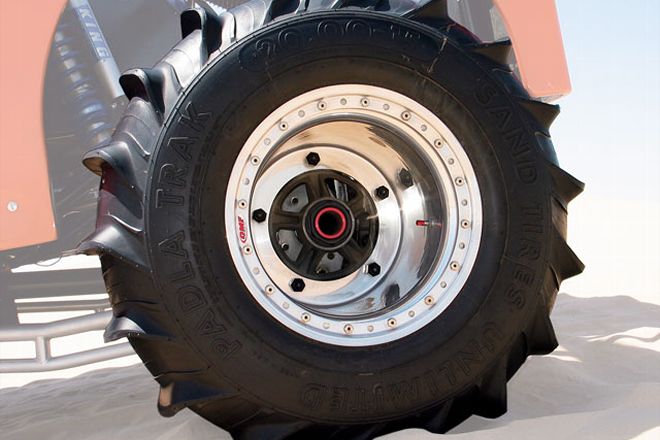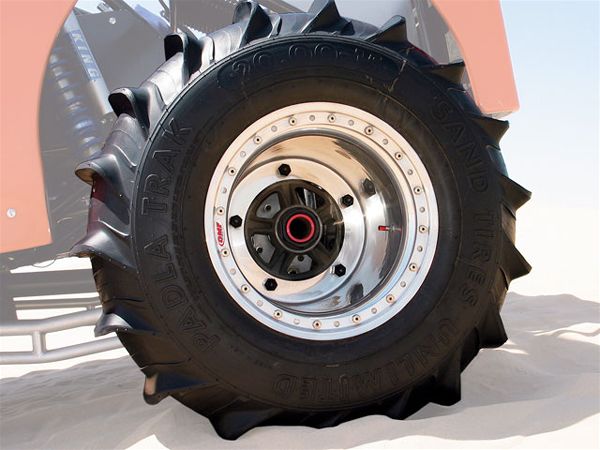
 Christian Hazel
Brand Manager, Four Wheeler
Christian Hazel
Brand Manager, Four Wheeler

You just can't write a review on one set of paddle tires and have it cover the whole topic. Just like we wouldn't review a Goodyear Mud Terrain and call its performance indicative of every mud tire, there are so many different styles, options, and designs to consider when talking about paddle tires that you can't lump them all into one category.
For starters, nothing throws mud, snow, or sand like a paddle tire. With any given number of scooping paddles vulcanized or formed to a tire carcass, you'd be hard pressed to find any other method of putting power to the ground that delivers as much bite. But therein lies the predicament. If you overdo it with too many or too aggressive paddles, you'll limit your wheel speed and fun. You want your engine to be able to just barely overcome the grip of the paddles so you can spin the tires to create wheel speed. Too little grip and you'll wind up shredding your paddles and ruining an expensive set of tires.
There is almost no limit to the number of options you've got in creating a set of paddles. Even when dealing with the production paddles, it's easy to get dizzy trying to figure it out-paddle height, paddle spacing, scoop profile, cut design, and so on. There's no set rule. And then consider overall tire width, vehicle weight, horsepower, suspension design, and wheel style all need to be taken into consideration when selecting the right set of paddles, and you'll see that your best bet is to contact the manufacturers directly for their advice. Our goal here is to simply equip you with some rudimentary info to get you going.
Unlike most off-road tire offerings, paddle tires can either be bought or built. Since many of the over-the-counter manufacturers cater to sand-drag and lightweight sand-buggy enthusiasts, more emphasis is placed on building a lightweight carcass than an overly strong carcass. They also try to create a carcass that will allow the paddle to crown so when the vehicle weight is on it, the paddle is flat to the terrain. With no crown, the center of the paddle won't bite as hard as the outer edges. To that end, most-if not all-paddle tires you can buy from dedicated manufacturers will have thin carcasses that are prone to debris punctures.
If you want a little added insurance, certain companies will vulcanize paddles to the bias-ply carcasses you supply. The benefit is twofold: you get a stronger carcass and a wider selection of tire diameters. Most over-the-counter paddles are in the 33-inch-and-smaller sizes. The downside is that it's harder to find a good carcass that's as wide as the over-the-counter versions, and the thicker carcasses won't all allow the paddles to crown. It's also common for guys to use drag slicks as the basis for a set of paddles, whether regular or wrinkle wall. Just watch your sliding and side-hilling if you go with the thin carcass.
For starters, it's not always true that the more paddles you have the more bite you'll get. It's a trade-off whether you want a larger number of shorter, less aggressive paddles or a smaller number of taller, more aggressive paddles. On the one hand, the shorter paddles will usually allow a bit more wheel speed, and the shorter paddles don't deliver the same vicious bite as the taller paddles. On the other hand, you usually pay per the paddle, so a tire with more than 30 paddle cups is going to set you back more than a tire with only eight cups.
The number of paddles obviously plays into the paddle spacing. Again, more paddles mean less spacing. If you've got a really high-horsepower vehicle (like more than 900 hp) and your vehicle is relatively light, you'll want to go with a tightly spaced, tall-cupped paddle tire. Conversely, if you're dealing with a regular 200hp, 3,000-pound Jeep, you'll probably be better off going with slightly fewer, much less aggressive cupped paddles.
And whether taller or shorter, there are several different over-the-counter cup or scoop profile designs for paddles ranging from mild to full performance. Different manufacturers offer different terminology to describe their paddle cut styles and designs. For example, Skat-Trak offers four over-the-counter paddle styles that range from 11/4 inches tall to 21/4 inches tall. And of those, there are varying degrees of profile and thickness to offer more or less flexibility, bite, and wheel speed. Thinner paddles will offer more slip, which is beneficial for lower-horsepower vehicles. Thicker paddles will give more bite, which is good for heavier vehicles or rigs with big power. What's more, you can alternate thick and thin paddles on the same tire. And of those paddle designs, the company offers the option of offsetting the paddles on the carcass if the width allows to increase flotation with little to no drawback in bite.
While we admit it's a fool's errand trying to spec out one paddle tire design that works equally well for every Jeep out there, we'll lay out the specs of Sand Tires Unlimited's 1650 Padla Trak tire, which in the sand community has a good reputation for performance on moderately built Jeeps and buggies. The company recommends its thin paddles for low-horsepower rigs and the thick paddles for rigs with up to 450 hp.
-Four-ply nylon cord construction
-33-inch height when mounted on an 18-inch-wide wheel at 5 psi
-Thirty-six 11/2-inch-high paddles spaced at 3 inches apart
-Equal number of thick and thin paddles alternately spaced
-Tire crowns for better compression
-Crazy sand traction
-Throws roosts like a jet boat
-Aggressive looks
-Single-purpose design
-Not for street or firm terrain
-Poor paddle and sidewall durability in debris-laden sand